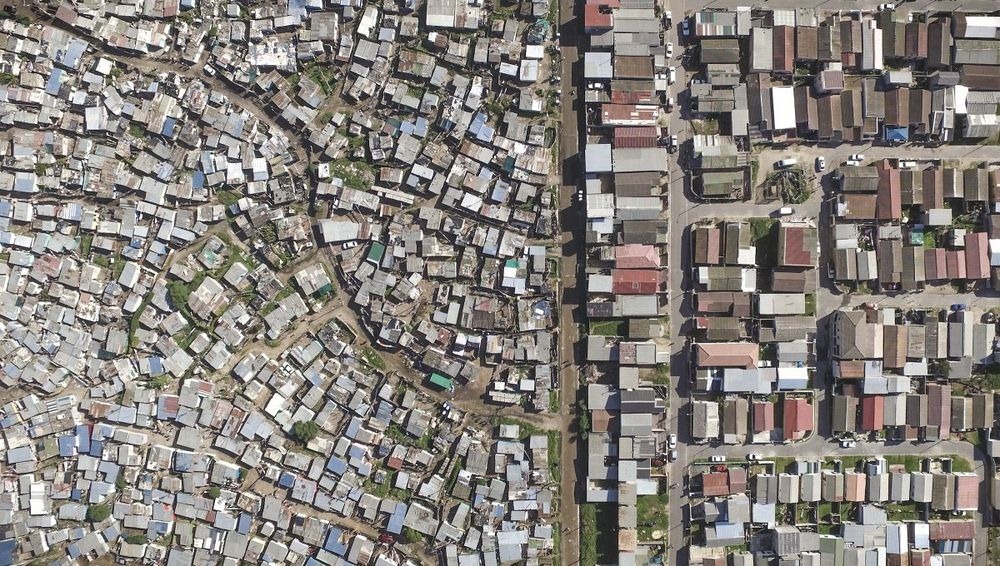Although South Africa’s apartheid era ended more than twenty years ago, there is still a palpable economic tension between the blacks and the whites. The black majority occupies the bottom rung of the society where they continue to be confronted by deep poverty, unemployment and inequality. The economic divide gets even more tangible once you get airborne. That’s what American Photographer Johnny Miller, who now lives in Cape Town, wanted to capture when he began his photo series “Unequal Scenes”.
“Drone photography is interesting because it affords people a new perspective on places they thought they knew,” Miller told CityLab. “Humans have this amazing ability to think we know a situation, having seen it so many times from the same perspective. It becomes routine, almost a pattern. When you fly, you totally change that.”
“I wanted to disrupt that sense of complacency that I felt, and that I knew a lot of privileged people in Cape Town feel,” he said.

So Miller took his drone to some of the most contrasting neighborhoods of Cape Town, such as Masiphumelele, a community of some 38,000 people, most living in small tin-roofed shacks. Just next to the impoverished area is Lake Michelle, an upscale suburban neighborhood where properties run into millions of dollars.
“I can tell you that it (segregation, inside Cape Town’s urban settlements) is desperate,” Miller said. “In some cases, it is like an urban hell. There is disease, there is crime, there is unemployment, there is anger, and there is hopelessness. Not in every single case, but in many. And literally, in some cases, next door, there are all the wealthy pleasures of life. Internet. Cars. Comforts. Swimming pools. Access to wealth. Jobs. Hope.”
Some of these ultra-rich neighborhoods are physically divided from the seedy shacks, sometimes by electric fences and guardhouses, and sometimes by wetlands. Many of these communities were designed with separation in mind. Others have grown more or less organically.
Miller says that the problem is not limited to Cape Town. Similar contrasting scenes exist in other South African cities from Durban and Johannesburg.
All images by Johnny Miller











“Drone photography is interesting because it affords people a new perspective on places they thought they knew,” Miller told CityLab. “Humans have this amazing ability to think we know a situation, having seen it so many times from the same perspective. It becomes routine, almost a pattern. When you fly, you totally change that.”
“I wanted to disrupt that sense of complacency that I felt, and that I knew a lot of privileged people in Cape Town feel,” he said.

So Miller took his drone to some of the most contrasting neighborhoods of Cape Town, such as Masiphumelele, a community of some 38,000 people, most living in small tin-roofed shacks. Just next to the impoverished area is Lake Michelle, an upscale suburban neighborhood where properties run into millions of dollars.
“I can tell you that it (segregation, inside Cape Town’s urban settlements) is desperate,” Miller said. “In some cases, it is like an urban hell. There is disease, there is crime, there is unemployment, there is anger, and there is hopelessness. Not in every single case, but in many. And literally, in some cases, next door, there are all the wealthy pleasures of life. Internet. Cars. Comforts. Swimming pools. Access to wealth. Jobs. Hope.”
Some of these ultra-rich neighborhoods are physically divided from the seedy shacks, sometimes by electric fences and guardhouses, and sometimes by wetlands. Many of these communities were designed with separation in mind. Others have grown more or less organically.
Miller says that the problem is not limited to Cape Town. Similar contrasting scenes exist in other South African cities from Durban and Johannesburg.
All images by Johnny Miller











Drone Photos Capture The Rich/Poor Divide in Cape Town
4/
5
Oleh
Chandu Numerology






